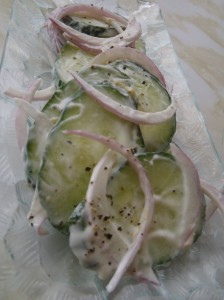Today was devoted to playing with the simple formula (dairy) + (heat) + (acid) = (fresh cheese), that is, changing the dairy, acid, and amount of heat to manipulate the taste and texture of the finished cheese.
Mascarpone
 Mascarpone, the most mispronounced of all Italian cheeses, is made from whole cream, and is usually curdled with lemon juice or straight citric acid. My recipe from the Culinary Institute of America’s Garde Manger, Third Edition,called for tartaric acid (available at brewing supply stores), the taste of which took a distant backseat to the rich, buttery flavour of the cream.
Mascarpone, the most mispronounced of all Italian cheeses, is made from whole cream, and is usually curdled with lemon juice or straight citric acid. My recipe from the Culinary Institute of America’s Garde Manger, Third Edition,called for tartaric acid (available at brewing supply stores), the taste of which took a distant backseat to the rich, buttery flavour of the cream.
- 1.92L heavy cream
- 1/2 tsp tartaric acid
Here are some brusque instructions. Heat cream to 80°C. Stir to prevent burning. Remove pot from heat and add acid. Once cream has formed curd, pour mixture into colander lined with cheesecloth. Refrigerate and let strain for twenty four hours.
Queso Blanco
Queso blanco, is another fresh cheese curdled with acid, cider vinegar in this case. While the pure citric and tartaric acids in the previous cheeses were almost undetectable, the cider vinegar makes its presence known. It has a crumbly texture, similar to ricotta.
- 1.92L whole milk
- 1 fl. oz cider vinegar
- 2 tbsp kosher salt
Heat milk to 85°C. Stir to prevent burning. Slowly add vinegar and salt while stirring. Once milk has formed curd, remove pot from heat. Pour mixture into colander lined with cheesecloth. Refrigerate and let strain for one to three hours.
Lemon Ricotta
 The queso blanco produced a large quantity of fairly clear whey, and the mascarpone left a small amount of relatively thick, opaque whey. I combined the two to make a third batch of cheese, something approaching a traditional ricotta.
The queso blanco produced a large quantity of fairly clear whey, and the mascarpone left a small amount of relatively thick, opaque whey. I combined the two to make a third batch of cheese, something approaching a traditional ricotta.
Loosely following a procedure for lemon cheese (intended for use with whole milk and cream, not whey…) I heated the whey mixture to 38°C, then slowly added lemon juice, stirring gently, until curds formed. I removed the pot from the heat, and let it sit at room temperature for a few hours. Then I strained the mixture for several hours to remove the whey.
I think the reason for the lower temperature in the recipe is this: since we want the lemon flavour to be fairly dominant, there will be lots of acid in the cheese, and therefore less heat is required to coagulate the proteins. With other cheeses like mascarpone, we don’t want lots of acidity in the finished product, so we need more heat to help coagulate the proteins.
The lemon ricotta had very fine, moist grains, and (obviously…) a strong lemon flavour. I added a bit of lemon zest and salt after straining, and mixed it with sliced cucumbers, red onions, and a few cracks of black pepper for a simple salad.